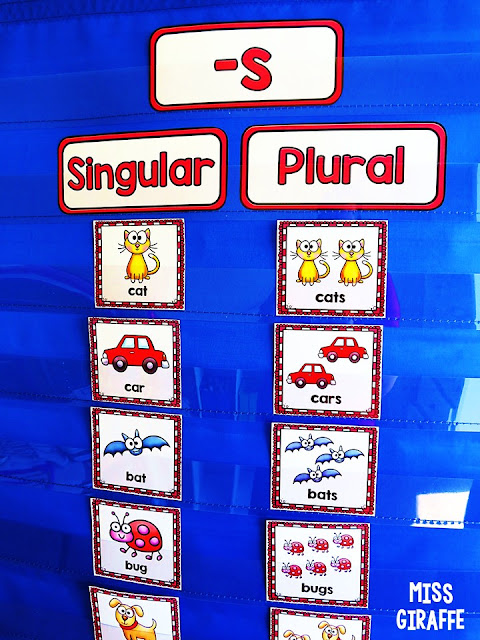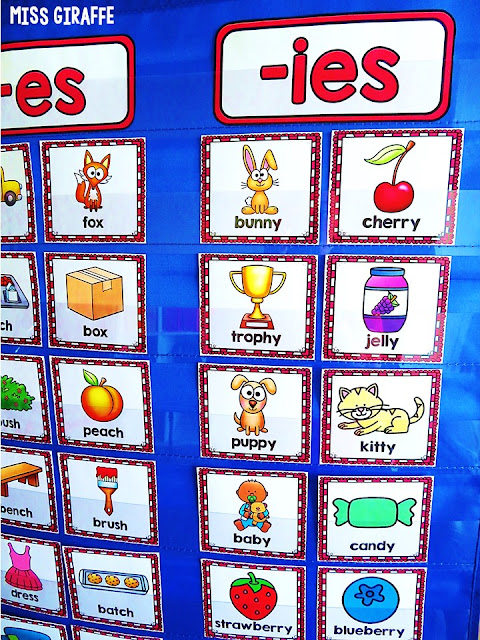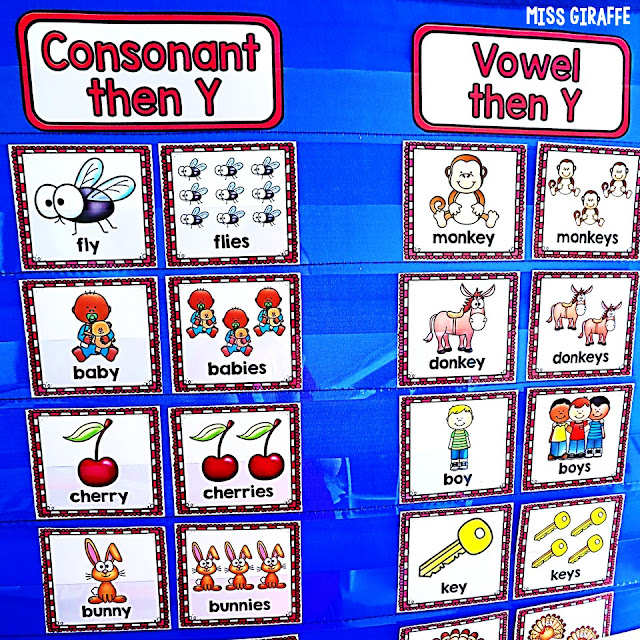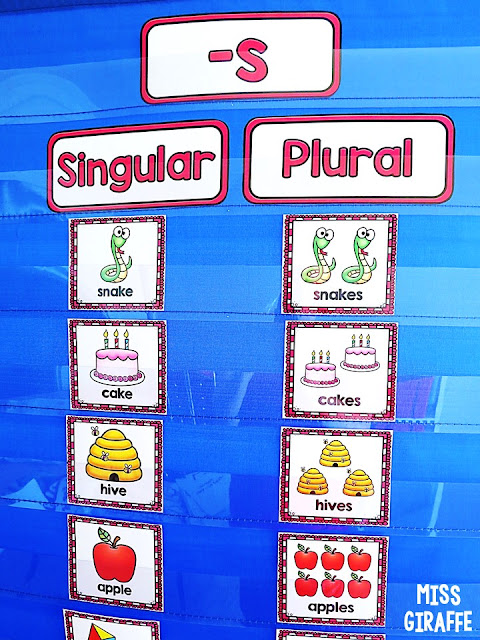It's actually fun to teach, I think, because you get to realize how silly English can be when a kid asks you why you can have cows but not sheeps. And your answer is probably, "That is a great question." :)
Irregular plural nouns can make it tricky BUT most words do follow some pretty basic rules so using pictures to give a lot of examples of each rule is my favorite way that I recommend to teach plural nouns.
Start with simply introducing a word that you have a picture card of (for example: cats). Then, ask them if you would say, "I have three cat." They'll giggle and say nooo, so you'll ask them what you say then. "Cats!" Repeat, "Ohh catSSSS. What did we add to the end of cat?" and hopefully they say "S!" If not, reinforce the "s" sound really quick. Introduce the "cats" card. Have them look at the 2 cards. Ask them how the words are different. They'll point out the S and you can explain how, with many words, all you have to do is add an S to the end to make it mean more than one. Tell them that is called plural. Plural is when there is more than one of something.
Repeat this with a few more words. Look at the picture above for examples.
"If you can read dog, you can read dogs!" so now you know 2 words.
Give a handful (10-15) of singular and plural versions of simple nouns and have them match them. As they match each one, have them say it: "Car... cars"
You can also play a fun matching game where you put all the cards upside down in a grid pattern (if you used 12 cards, do 4 x 3 for example). Then take turns flipping them over to make a singular/plural match. If they make a match, they keep the cards. If they don't, they flip them back over and it's the next person's turn while they try to remember where the matches are.
That's super fun practice!
Make sure to use the word "singular" to describe only one while learning this lesson so they learn both vocabulary words. I also recommend using the headers I show above while sorting/matching so they get used to the new terminology.
That's also a really quick sort they can do to review those terms. Give them the headers and have them sort pictures as to whether the picture noun is singular or plural.
The next lesson is to introduce words that become plural by adding -es to the end of it.
Let them know that sometimes you add -es to a word to make it mean more than one.
I recommend starting with foxes and boxes since those are probably words they can spell, so they can see the "es" on the end of it. Break "es" into short e + ssss so they hear essss. Say "lunches" and ask if they hear "lunchs" or "lunchES" - repeat with benchES. CouchES. Let them hear the "es" and the difference to "cats." Say "CatES" and ask them if that sounds correct. Be silly, they'll love it :)
Now, have them sort the PLURAL cards as to whether they have "s" at the end or "es." I recommend giving them the words with the pluralizing suffix already on it.
Although you can make it more difficult (or differentiate for more advanced students) by giving them the singular cards and have them decide if they think it's -s or -es like this:
That's pretty tricky! This is a great assessment, though, if you want to see whether they understand the rule.
They should know the rule where, typically, if a word ends in X, S, SH, CH... you add -es to make it plural.
Practice this a lot before moving on. This is possibly several lessons and rounds of practice before you move on to -ies words.
You can also give them a lot of support by giving them both versions of the card so they can properly sort it but also self-check it. This makes it a much more independent activity (since they can verify if they are correct) while also providing a lot of support.
There are so many ways you can do it - it really depends on where you feel your learner is.
I like this approach because they can see exactly how the word changed.
Words that end in Y add IES
Once they've solidified -s and -es words, start with words that end in y!
There are several smaller lessons for this rule. I recommend starting with simple 2 syllable words that end in y: bunny, puppy, cherry, candy.
Ask what you have if you have more than 1 puppy... puppies!
What do you have if you have more than 1 cherry? Cherries!
Have them hear the IES sound at the end of the word & tell them it's spelled -ies.
Do another match to show how the y turns into -ies at the end of the word.
I recommend ONLY using words that make the long E -ies sound at first to keep it simple for younger students. Skip the long i -ies words for now.
For example: candies, bunnies... NOT fries, flies. Not yet at least. :) More on that later!
Now that they have learned the 3 plural endings to words, I recommend doing a sort of TWO of them. You can do 3 if you really want to, but sorting -es and -ies is a great lesson.
Then, you can sort all 3 that you've learned!
You can do this by giving them the already plural version of words (cats, buses, bunnies) for them to sort by the word's ending OR you can give them the singular version of the word (cat, bus, bunny) and have them decide how to make it plural.
You could also do it with the plural words first then later without to assess/practice more.
Having the word already be plural (buses) definitely gives a lot more support but it is still great practice, especially when first learning these rules.
Important Note: The picture above shows long I -ies words (example: flies). I still would only include -ies words with the long e sound (skip words like flies) for this sort at this point.
You can also make this sort easier by giving both versions of each word like we did for the -s -es word sort:
This is my favorite way to do the sorts because they can see both ways and how the word changes. It's a great visual representation of what they're actually doing when they add a plural ending.
Once they've really internalized those 3 concepts (add S for most words, add -ES if the word ends in S X CH SH, and replace the Y with IES if it ends in Y)... NOW is when I would introduce long E -ies words.
Long E -ies Words
These are words like fly and fry that turn into flies and fries.
When introducing dropping Y to add IES words, you only did Long E sounds. Now you can include words where IE makes the long I sound.
I recommend a simple sort like this to show them how Y can say eeee or I & when they change it to IES, it follows what the Y did.
Quick note - if you already learned the 3 Sounds of Y, then you could include them all from the beginning. If you need help teaching that skill, I have a lot of Sounds of Y resources! I have this awesome set of picture cards so you have a lot examples. I also have a HUGE pack of worksheets and no prep activity pages all focusing on Vowel Sounds of Y if you need to introduce and practice it. If you've already learned it and just need a super quick review, I have this free little worksheet to practice Sounds of Y. I prefer using word cards if you haven't already explicitly taught it.
Plural nouns are usually taught before knowing those phonics skills, though, so that's why I think the Long I -ies words should be saved for well after you've learned the foundation skills for singular/plural nouns. It's just too confusing to do them both at the time time, I feel.
Same with how you're probably teaching this skill way before learning the IE sound that -ies uses. If you need help with that skill, I have a giant IGH and IE No Prep Pack as well as IGH and IE picture cards and IGH IE Clip Cards! I *love* phonics so I have fun stuff for every sound honestly. If I have something for one sound, I probably have it for all of them :)
I don't recommend doing all of those vowel sounds of Y and IE activities with this. I'm simply pointing out how those are sounds they'll learn later and probably don't know yet. Eventually they'll learn how there are both long E and long I sounds for Y and IE.
All they need to know right now is how Y can say eeee or I and the IES will say whatever the Y did.
For now, I'd simply tell them how Y can say E or I & that, in both cases, they drop the Y and add -IES to make it plural.
ADVANCED!
This is a somewhat advanced rule. It's helpful though. If you're teaching kindergarten, I'd probably skip this lesson entirely.
You don't always drop the Y to add -IES. Only if the Y is after a consonant.
If the Y has a vowel right before it, you simply add an S.
Again, this is a pretty advanced rule but I wanted to include it for the sake of being thorough.
There are a lot more random rules!
Words that end in E add S
Another time you simply add S is when the word already ends in E. So, technically, the words does end in -ES but you only added -S to the word to make it plural.
For example, cake becomes cakes. It technically ends in es but adding an S is what made it plural.
Once you're ready to get a bit more complicated, you can show them how sometimes there is ALREADY an e at the end of a word, so all you do is add an s!
For example, above, "cake" becomes "cakes" not "cakees" which they will think is funny if you say cake-es :)
If you haven't learned long vowel CVCe words, then I would wait until then and bring this out then. By then, it'll seem really easy to them and can be a fun review. Plus you'll have all these cards for learning long vowels!
It's not just CVCe words, though. If you notice in the picture above, words like "apple" also apply to this rule.
Plural F to VES
Another random seeming rule is how words that end in F often drop the F and add VES.
This is another skill you can choose to do now or address later or if it comes up. I wouldn't overwhelm a child with all of these rules at once unless they're an older student and you want to make a quick list of all the possible rules.
I like learning to be organic so while you're teaching -s -es -ies... if they happen to come upon wolf and you need to explain why it's not wolfs, then you could do this as a quick 10-15 minute activity to explain this rule.
and then there are the totally, completely...
Irregular Plural Nouns
Nouns that don't follow the rules at all! :) They enjoy finding these!
I have a lot of games I like for practicing these words!
I recommend bringing the "Singular" and "Plural" headers out again and have them simply place the singular version of the word and plural version of the word side by side like they did when you introduced -s -es and -ies.
Tooth & teeth. Person & people. Woman & women.
This is a great lesson to play the matching game I talked about earlier where you flip all the cards over and try to make matches. The pictures are obviously a huge help, but make sure they're saying both "ox" and "oxen" when they make a match.
I also include a "Same" header so you could put that at the top and use it as a column where words stay the same (such as fish, sheep, deer). This is a fun column you could throw into any sort (-s and Same... -es and Same) to teach the concept of how some words stay the same.
Irregular plural nouns are simply ones they have to memorize. You can point them out when you come across them in conversations naturally. This is another easy way to make the concept of plural nouns silly and fun. Call mice meeses and deer deeries and let them correct you :)
I hope you found this post helpful!
If you want these picture cards I am using as examples, they are here:
All of the cards you see in this post are from that pack. It includes A LOT of cards and a lot of sorts with the headers already made for you. You can use these to simply introduce the concept, use them to play games, have kids sort them, have kids write them... I have heard of so many different ways people use my grammar and phonics pocket chart centers so it's really up to you!
I also show more ideas for plural nouns in my Prefixes and Suffixes Teaching Ideas blog post including my plural nouns puzzles and posters if you want to explore this topic more :)
I am very excited that I have been posting a blog post every week this summer, starting at the beginning of July. I absolutely love sharing ideas with you and it has been a fun challenge! It has definitely been a challenge but one that I have enjoyed.
If you want to read my most recent posts... So far this summer I have posted:
I also have A TON of blog posts where I share my favorite ideas that you can find organized here:
Thank you for stopping by! I appreciate you coming to my little corner of the internet for a bit and hope you come back again soon! :)










































0 comments:
Post a Comment